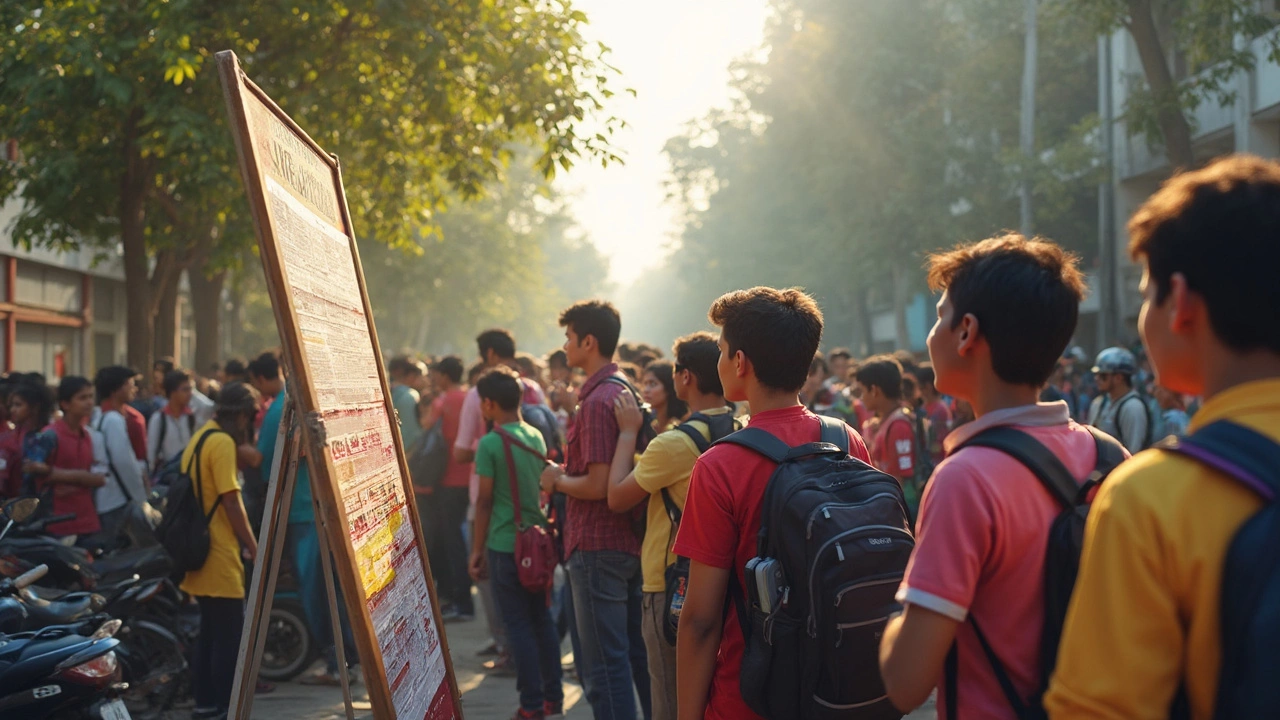Ask any JEE aspirant which IIT is the toughest to crack, and you’ll probably hear the same three names: Bombay, Delhi, Madras. But is it just about the hype, or is there something deeper at play?
If you look at the cut-off ranks for Computer Science, IIT Bombay’s closing rank often hovers around AIR 60. That means if you aren’t in the top 60 in the country, you don’t even get a shot at CSE in Bombay. It’s ridiculously competitive. But here’s the twist—other IITs like Delhi and Madras are breathing down its neck, and the difference in closing ranks is razor-thin.
Pay attention to the total number of seats. IIT Bombay offers fewer seats than, say, IIT Kharagpur, which drives competition even higher. Plus, everyone loves the campus culture (and the Mumbai vibes), so demand explodes. But don’t get fooled—sometimes the real battle is in the branch you pick, not just the IIT itself.
Instead of just gunning for names, dig into the trends. Look at branch-wise closing ranks, reservation category stats, and how seats change each year—sometimes a small shift adds or removes hundreds of spots for a course. The trick is to match your AIR and preferences with these details, not just follow the crowd.
JEE Advanced is brutal. Every mark counts, and the gap between a dream seat and a heartbreak can be a single question. Want an edge? Spend some time understanding the data—not just last year’s, but three or four years’ worth. Spot the patterns, and use them to plan your strategy.
- Why Everyone Wants the Top IITs
- Decoding the Allure: Bombay, Delhi, or Madras?
- Cut-Offs, Seat Matrices, and AIRs Explained
- What Makes an IIT Tougher Than the Rest?
- Insider Tips for Beating the Odds
- Choosing the Right IIT For You
Why Everyone Wants the Top IITs
The hype around the top IITs isn’t just some old legend. Ask anyone from the coaching centers in Kota to the seniors at any engineering school—everybody has their reasons, and honestly, they add up.
Let’s be real: the top IITs like Bombay, Delhi, and Madras have set a benchmark. These places aren’t just about cracking the hardest IIT; they’re a ticket to killer careers, global opportunities, and a campus life that’s hard to beat. When companies visit for placements, they’re more likely to offer the fattest paychecks at these big names—sometimes straight out of a dream.
- Placements: In 2024, IIT Bombay’s average CTC for B.Tech was around ₹24 lakh, with top offers going north of ₹3 crore (international roles included).
- Alumni Network: Top IITs have a strong alumni community. These connections can hook you up with internships, jobs, or even startup funding.
- Research and Innovation: Projects and labs are world-class. Sponsored projects bring in serious money, with IIT Delhi crossing ₹500 crore in research funding last year.
- Campus Life: Fests, clubs, sports, tech events—the student life here really is next level.
Check out how the most popular IITs stack up on core stats:
| IIT | Opening Rank (CSE, 2024) | Average CTC (2024) | Number of B.Tech Seats |
|---|---|---|---|
| IIT Bombay | 1 | ₹24 lakh | 110 |
| IIT Delhi | 2 | ₹23 lakh | 120 |
| IIT Madras | 3 | ₹21 lakh | 113 |
It’s not just about numbers. The prestige sticks for life. When grads say they’re from an old IIT, doors open—whether it’s jobs, grad school, or getting into that cool startup scene. That’s why competition for these campuses is wild, and why thousands fight for every single seat.
Decoding the Allure: Bombay, Delhi, or Madras?
If you’ve hung around JEE aspirants or scrolled through Quora threads, you know how often everyone battles over which of the big three—IIT Bombay, IIT Delhi, or IIT Madras—is the most coveted. There’s more at play than names or bragging rights. There’s campus life, placement records, city vibes, and even hostel food making the decision tricky for toppers.
Let’s talk numbers. IIT Bombay’s B.Tech Computer Science cut-off rank in JEE Advanced 2024 was AIR 66. For IIT Delhi, it was AIR 107, and Madras closed at AIR 175. That’s not just a difference of a few spots. The top 100 All India Ranks get split between campuses, mostly fighting over Bombay and Delhi.
| Institute | 2024 Closing Rank (CSE) | No. of CSE Seats |
|---|---|---|
| IIT Bombay | 66 | 110 |
| IIT Delhi | 107 | 123 |
| IIT Madras | 175 | 104 |
Why does everyone chase Bombay? Simple: It’s a magnet for top tech firms—think Google, Microsoft, and Apple try to scoop talent here first. The chilled-out Powai campus life, Bollywood neighbors, and legendary student culture get a lot of buzz. Plus, alumni connections make internships and jobs easier to crack. As one ex-IITian and now Google engineer put it:
“IIT Bombay just opens doors. The peer group is crazy smart, the city is alive, and opportunities almost find you—if you’re ready.”
Delhi’s not far behind. With a prime location in the heart of India’s capital, the exposure is wild—think startups, research, and weekend trips to Connaught Place. Placements here also stay neck-and-neck with Bombay, especially for CSE and Electrical. Faculty are known to be a tough but supportive bunch.
IIT Madras attracts those who want innovation, especially in core engineering. Its campus, away from city chaos and lined with deer, gives space to focus. Placements, especially for computer science and mechanical, are top league—major companies don’t skip this campus. But, the southern location means the crowd is a bit more diverse and sometimes less North-heavy.
So, what drives the crazy demand?
- hardest IIT tag tied to Bombay and, next, Delhi—everyone wants a shot at the very top
- Placements—big IT and consulting firms come here first
- Location—access to tech scenes (in Mumbai and Delhi especially)
- Campus vibe—the culture, network, and even the alumni reunions are famous
If you’re picking between these three, don’t just look at cut-off ranks. Think about what excites you—city life, peer group, or field of study. That match decides not just your admission, but your next four years and beyond.
Cut-Offs, Seat Matrices, and AIRs Explained
If you want to crack the code on which IIT is the hardest to get into, you need to get real about three things: the cut-off ranks, the number of seats (that's the seat matrix), and your All India Rank (AIR). These numbers change everything.
The hardest IIT to get into usually means the one with the toughest cut-offs for its top branches, mostly Computer Science. Just look at the data from JEE Advanced 2024:
| IIT | Branch | Closing General Category Rank (2024) | Total Seats (CSE) |
|---|---|---|---|
| Bombay | CSE | 66 | 173 |
| Delhi | CSE | 96 | 120 |
| Madras | CSE | 146 | 126 |
| Kanpur | CSE | 215 | 120 |
| Kharagpur | CSE | 302 | 188 |
If you’re aiming for IIT Bombay CSE, you need to be in the top 60-70 in the country. The difference between Bombay and Kharagpur is nearly 240 ranks for the same branch. That’s how tight the game is.
Seat matrices matter just as much. If there are fewer seats, like in Delhi’s CSE (120), the fight is brutal. Sometimes, a slight increase or decrease in seats can decide whether you land your dream branch or not.
Here’s how you should use these numbers:
- Find the most recent cut-off for your preferred branch and college. Don’t use ancient data; look up the latest cut-offs published on the official JoSAA website.
- Check category-specific cut-offs, not just general. If you’re from SC/ST/OBC/EWS, cut-offs are different but still unpredictable, especially in top IITs.
- Seat matrix isn’t just for the whole college—break it down branch-wise and category-wise. Sometimes, colleges increase seats for new courses, which can lower closing ranks a bit in less popular branches.
- Your AIR decides everything, not your board marks or JEE Mains score. So, focus on getting a top AIR in JEE Advanced.
Don’t just memorize numbers—work backward. If you’re seeing that CSE in Bombay is way too narrow, can you target a good branch in Madras or Kharagpur where you’ll have a better shot? Play smart with the data; it’s not about prestige, but alignment with your own score and future goals.

What Makes an IIT Tougher Than the Rest?
So, why is one IIT like Bombay considered harder to get into than, say, Roorkee or Hyderabad? It comes down to a brutal mix of prestige, seat numbers, placement stats, and what toppers want. Let’s break it down piece by piece.
First, every year, the top rankers of JEE Advanced fill their choices in a certain way. Their preferences set off a domino effect. The ones with the best All India Ranks (AIRs) almost always lock their choices to the hotshot IITs: Bombay, Delhi, and Madras, with Computer Science and Electrical Engineering as top picks. The branches and campuses attract those who can literally choose anywhere they want, so competition for these combos goes off the charts.
Here’s what really bumps up the difficulty:
- Brand Value: The big three (Bombay, Delhi, Madras) have a reputation for great campus life, industry links, and famous alumni. It’s what makes them dream colleges for toppers year after year.
- Placements and Salaries: The highest placement packages are often snapped up in these IITs, especially for CSE. In 2024, IIT Bombay’s average CSE package was around ₹35 lakhs per annum—with some outlier offers hitting the ₹2 crore mark. Not many other campuses can match this.
- Seat Crunch: The number of seats in the core branches is painfully low. There are just 124 seats in IIT Bombay’s CSE batch, while IIT Delhi CSE barely offers 120. Compare that to thousands (yes, thousands!) of students aiming for those seats.
- Cut-Offs: Check out the closing AIRs for the last five years: the numbers don’t budge much. Even in years when the paper is tough, you’ll see Bombay CSE wrapping up around AIR 60-70.
Let’s put some real numbers on the table. Here are the 2024 closing AIRs for the most desired branch (CSE) at the top IITs:
| IIT | CSE Closing Rank (AIR) - 2024 | Total CSE Seats |
|---|---|---|
| IIT Bombay | 67 | 124 |
| IIT Delhi | 104 | 120 |
| IIT Madras | 175 | 119 |
| IIT Kanpur | 236 | 124 |
| IIT Kharagpur | 285 | 188 |
What really makes the hardest IIT to get into? It’s not just the rank cut-offs. It’s the relentless demand from the best of the best, low seat numbers, a brand that everyone trusts, and results that speak for themselves in both placements and research opportunities. The deck is stacked, and unless you’re in the top 100 or so, you’re usually looking at the next best options—even if your score would get you CSE in plenty of NITs or new IITs.
Insider Tips for Beating the Odds
If you’re dead set on grabbing a seat in the hardest IIT, you can’t just rely on being "smart." You need an actual plan that goes beyond typical coaching tips. Here’s a straight-up approach that JEE toppers actually use:
- Hack Previous Year Papers: Don’t just solve them—analyze them. Notice the topics that are repeated almost every year. In Chemistry, for example, questions from Organic Reaction Mechanisms and Coordination Compounds show up alarmingly often. In Physics and Math, certain topics like Mechanics, Algebra, and Calculus are always high-weightage.
- Balance Mock-Test Volume and Analysis: Doing 70 mocks is useless if you aren’t checking your silly mistakes. Toppers usually do fewer (about 40-50), but they go deep into each one, figuring out their weak topics and changing strategy accordingly.
- Smart Revision: Most students waste time reading everything again and again. Instead, use short notes, error booklets (where you log mistakes), and flashing formulas on sticky notes around your desk. This keeps things fresh without drowning you in 600-page books.
- Fix Your Sleep and Exam-Time Routine: Replicate JEE exam conditions at least twice a week for the last two months (same time, same environment). It actually trains your brain to be sharp at 9 AM on d-day.
- Know the Competition: Stats help. Just check this out:
| IIT | Branch | Seats | Closing Rank (2024) | Applicants per Seat |
|---|---|---|---|---|
| IIT Bombay | CS | 124 | 66 | ~1700 |
| IIT Delhi | CS | 103 | 116 | ~2000 |
| IIT Madras | CS | 78 | 176 | ~2500 |
You can see why these numbers freak people out; for every seat, over a thousand students are in the race. The margin for error is razor-thin.
- Don’t Ignore Counselling Strategy: Rank is just the start. Every year, students miss out on a seat they could’ve easily landed because they filled their choices wrong or didn’t know branch cut-offs. Double-check latest seat matrices, opening/closing ranks, and use the mock allotment rounds to tweak your list.
- Last-Day Calm: The last months aren’t for learning new stuff. That’s the rookie mistake that tanks JEE scores. Use last weeks for targeted revision and keeping your stress lower than usual—sometimes, the difference is just thinking straight on the big day.
Want a numbers-backed edge? AI-based JEE prep tools like Embibe or Unacademy Plus have diagnostic reports telling you topic-wise accuracy and ability compared to the national topper pool. Don’t ignore these—they pretty much show you where to put your effort for the biggest gain.
Choosing the Right IIT For You
Choosing the right IIT is not about following what everyone else says. It's about what fits you—your rank, your interests, and even your comfort zone. Sure, IIT Bombay, Delhi, and Madras get all the hype, but did you know IIT Kanpur actually scores the highest for student satisfaction according to the 2024 NIRF survey? And IIT Kharagpur offers the most number of BTech seats, giving you more options if your JEE Advanced rank isn't right at the top.
Let’s get real with a few honest tips. Don't make your entire decision based on just opening and closing ranks. Consider:
- Placement stats for the branch you want (these can differ by a lot even within the same IIT)
- Campus life—some folks love Mumbai’s energy, others vibe with the big Kharagpur campus surrounded by greenery
- Your AIR and category reservations (cut-offs swing a lot in OBC, SC, and ST lists each year)
- Future plans—want to join a specific research group or a top coding club? Some IITs are better for certain specializations.
Here's a quick comparison of closing ranks for CSE in different IITs in 2024:
| IIT | Closing Rank (CSE, Gen) | Total BTech Seats (All Branches) | Popular Perks |
|---|---|---|---|
| Bombay | 66 | 1100 | Startup scene, location |
| Delhi | 115 | 1100 | Industry exposure, fests |
| Madras | 175 | 1130 | Peaceful campus, research |
| Kanpur | 215 | 1190 | Student satisfaction, pure sciences |
| Kharagpur | 295 | 1869 | Biggest campus, variety of courses |
Every IIT has its edge. If you’re aiming for the hardest IIT just for bragging rights but you’ll hate the city or the course, it’s not worth it. Weigh the data, talk to current students if possible, check YouTube vlogs, and see what feels right for you—not just what looks good on paper.
One more pro tip: Older IITs are great, but new ones like IIT Hyderabad and IIT Indore have leveled up fast, especially in coding and internships. Don’t overlook them just because they don’t have a famous name yet.
- Match your JEE rank to last four years’ cut-offs
- List out your branch preferences and compare them with placement stats
- Look up hostel life, clubs, and city culture—small things can make a big difference for four years
Picking an IIT isn’t just a line on your future resume. It’s where you’ll spend some of the most important years of your life. Make it count for you.




